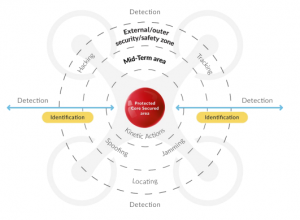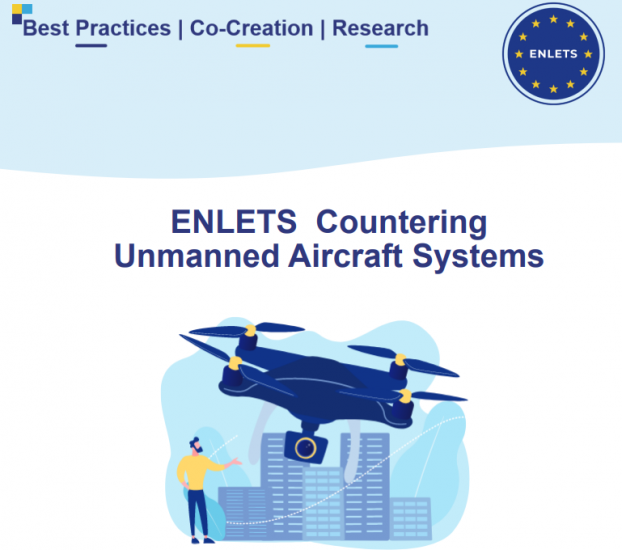The European Network of Law Enforcement Technology Services (ENLETS) has published its final report on Countering Unmanned Aircraft Systems. The report sets out a summary of the Counter-Unmanned Aerial Systems (C-UAS) Technology Interest Group (TIG) activities; and a summary of the C-UAS technology interest group subgroups activities. The project was funded by the European Union’s Internal Security Fund – Police Programme under Grant Agreement no 814756.
Many European nations have been searching for proper way to control the UAS threat in their countries. The major challenge is to have the proper technology to protect urban environments. The first findings from C-UAS TIG were that most of the detection and neutralisation technology solutions are working well in open areas. In a city and build up environment (high buildings etc.) the systems are not working well, and the Law Enforcement Agencies (LEA) are facing more challenges than benefits.
There are several different action steps in Counter Action procedure from the LEA perspective. In the C-UAS operational process, actions and terminology overall are categorised for three main areas:
- Detection and tracking of overall flying UAS system.
- Identification and verification of the UAS that is causing the reason to clarify the purpose of the flying because of the flying direction or other abnormal behaviour in the outer/external safety/security zone.
- Description of different actions related to the estimations of the safety/security zones. To estimate safety/security zones for different actions and assess the size of the safety/security zone for the external, mid-term and protected core areas.

It is relevant to benchmark the most suitable intervention systems and find out the system gaps in different safety/security zones. It is necessary for ENLETS C-UAS TIG to have an entire picture of the available systems to produce TIG’s activities. This activity was done in cooperation for instance with COURAGEOUS and other projects/networks. The intervention abilities should be assessed from the perspective of safety/security zones.
Challenges regarding C-UAS
There are number of challenges in counter measurements.
- To have a good operative situation picture of the airspace extending at least five kilometers.
- The biggest technological challenge in the field of neutralisation is the possibility of identification and disruption of a particular “enemy” drone, or taking control of this aircraft without disrupting other permitted UAS operations.
- Counter UAS technology is expensive technology and because of that some of the countries are without the special counter technology.
- Small covering area of C-UAS technology.
- The national law and tight frequency limitations for jamming technology.
- Testing standardization of C-UAS devices. Testing is time consuming. The manufacture testing presentations are usually in open environment. The challenge is urban city environment
- Small and fast noncooperative UAS devices.
- How to take-over of command-link of UAS?
- Electronic fencing technology without disturbing GNSS-Signals.
- UAS based on 4G, 5G (and next gen) communication.
- Standardization/certification of C-UAV technologies. Nowadays, all C-UAS technologies need to be tested before LEA can evaluate their efficiency.
- Material capability to do counter measurement actions. Military cooperation is good, but when there is need for military own use, you may not rely too much for military support.
The report found that C-UAS requires a great deal of cooperation from industry, research, law enforcement, networks and projects. It says at present the various detection systems need a comparative observation system alongside each other to support each other in order to obtain the best possible situation in the environment. The need for law enforcement is twofold; find solutions that can be built in place and quickly move. The key objective is that the law enforcement authority has the equipment to be able to extract dangerous-behaving items from other safe-flying destinations.
The built urban environment is a challenge for counter-action. Presentation of equipment to law enforcement authorities often takes place in open locations where there are no other blind spots than the city in the environment. One important development, therefore, would be to define for industrial operators certain requirements and standards needed by law enforcement authorities to ensure that the equipment is operational. In this way, law enforcement authorities will be able to save a lot of resources and time when they have access to up-to-date information on equipment that meets the basic requirements of the operating environment. In addition, from the point of view of the law enforcement authority, the equipment to be transferred should be so automated with regard to the calibration of parameters that separate engineering skills would be unnecessary for the installation of the equipment in a new operating environment.
Technology Interest Group (TIG)
The C-UAS TIG Group is a continuation of the previous Drone Technology Interest Group. The experience gathered in the Drone TIG appeared crucial to understanding the operational concepts and potential threats caused by UAS’s. The group is supported by an Advisory Board made up of representatives of DG HOME of the European Commission (Unit D.2 CounterTerrorism).
ENLETS connects 30 European states, providing an environment that promotes collaboration and stimulates knowledge transfer. The network fosters relations between various actors essential for improving the safety and security of Europe.
ENLETS is a subgroup of the Law Enforcement Working Party (LEWP) reporting to the Standing Committee of Operational Coordination and Internal Security (COSI). It was created in 2008 to establish a stronger connection between law enforcement agencies (LEAs) and innovative technologies. ENLETS’ main goal is to operationally strengthen Law Enforcement (Police) with the use of modern Technology and Development by exchanging information, experience and knowledge on a practical communication level.
For more information contact:




